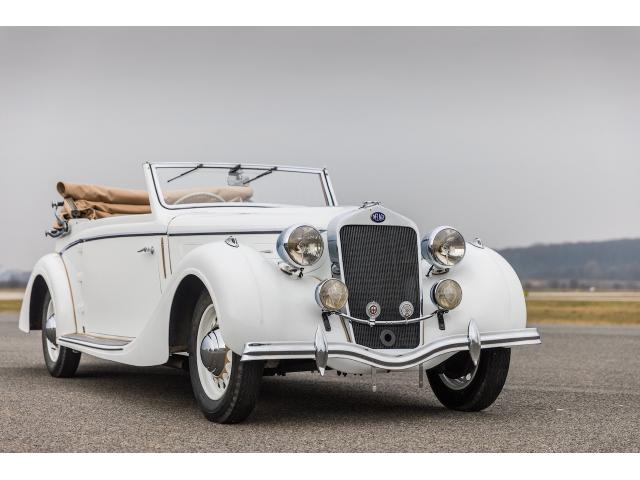1937 Delage D6-70 - Cabriolet by Henri Chapron
- Brand: Delage
1937 Delage D6-70 - Cabriolet by Henri Chapron
Louis Delage was born in 1874 and was handicapped by blindness in one eye. This handicap would not hinder him at all in creating some of the most elegant and beautiful creations of the pre-WWII era, and into the early 1950s. He acquired his engineering abilities while working for Peugeot. He worked with the company until 1905, when he left to build cars bearing his own name.
Delage had a strong loyalty to France, and he endeavored to build cars that would bring honor to his country. He began racing in 1906 and acquired some success. By 1913, he had constructed a worthy racing machine to claim the Grand Prix de France. His racing machines continued to evolve. In 1914, they featured double overhead camshafts and brakes on all four wheels.
Rene Thomas drove a Delage in the 1914 Indianapolis 500 where he emerged victorious. In 1924, he set a land speed record at just over 143 mph.
During World War I, the newly built factory in Courbevoie was used for the production of military items.
During the mid-1920s, the Delage cars were powered by eight-cylinder engine displacing 1.5-liters. In 1927, Robert Benoist drove a Delage with an inline-eight cylinder engine to a victory at the Grand Prix de France, Spanish Grand Prix, British Grand Prix at Brooklands, and the Grand Prix de l'Europe at Monza. After this brilliant accomplishment, Delage announced his retirement from racing.
Delage had left the sport on a high-note, but there were troubled times in its future. The Great Depression rattled many industries, including the automotive world. By 1935, Delage had felt the strains of this painful time in history, and was forced to enter liquidation. A Delage dealer named Walter Watney purchased the company's assets. This proved to be a pipe-dream for Watney, and soon was looking for aid from an automotive partner who could help bear the costs of engineering, development and manufacturing. Luckily, he found the assistance he was searching for - at Delahaye. An agreement was reached which allowed the Delage name to continue.
After the Delahaye take-over in 1935 the Delages were constructed to Delahaye designs while retaining their own short-stroke engines and hydraulic brakes. In 1937 the D6-70 was introduced featuring Delage's powerful 2729cc overhead-valve six-cylinder engine and mated to a Cotal electrically operated four-speed gearbox.
A Speciale version of the D6-70 was constructed with Joseph Figoni commissioned to construct the aerodynamic body. It had a Delage prepared three-liter six-cylinder engine and mounted on a Delahaye 135 chassis. It was constructed to race in the 1936 24 Hours of LeMans but the race was cancelled due to strikes across the country. Its competition career took a slight detour - it was shown at Concours d'Elegance events where it had a profound impact on many that were in attendance.
The following year the D6-70 Speciale finally made its inaugural competition debut at LeMans. It finished first in class and fourth overall, behind a Bugatti and two Delahayes. The Figoni coupe body was later removed in 1938 and fitted with a Figoni & Falaschi roadster body. It continued its racing career, with highlights including a victory in the 1938 Tourist Trophy. This success spawned two similar cars for 1939, but with further modifications including a lightweight chassis.
The lightweight cars were raced at LeMans where the experience and lessons-learned paid off with another first in class and second overall. War would postpone the efforts for several years; after the war, Watney commissioned five racers similar to the lightweight cars. The three-liter engine now produced 142 horsepower and clothed in a body with cycle-fenders and lightweight materials.
These five new cars, as well as the original Speciale, did well in racing during the post-War era, with several significant victories. Four cars were on the starting grid at the 1949 24 Hours of LeMans. After 24 hours of intense racing, a first and second in class had been achieved, and a very impressive fourth overall with a Ferrari 166 taking the first.
As the 1950s came into view, the six-cylinder engine was showing its age. At the 1950 LeMans race, only one car was entered and managed to finish the race but in seventh place.
Delahaye searched for funds to revitalize their racing program, but they had little luck. Production continued for only a few more years, ending in 1953 when the company entered bankruptcy.
The Delage D6-70s in production trim were raced with much success beginning in early 1937. With strong finishes at the Rallye Monte Carlo and Rallye du Maroc, the Delage's earned a reputation for their speed and durability.
This car chassis with a body called „Dandy“, was designed by Henri Chapron and it’s known as one of the most attractive body every build on D6.
| Specification | |
| Production Start | 1937 |
| Country of origin | France |






















